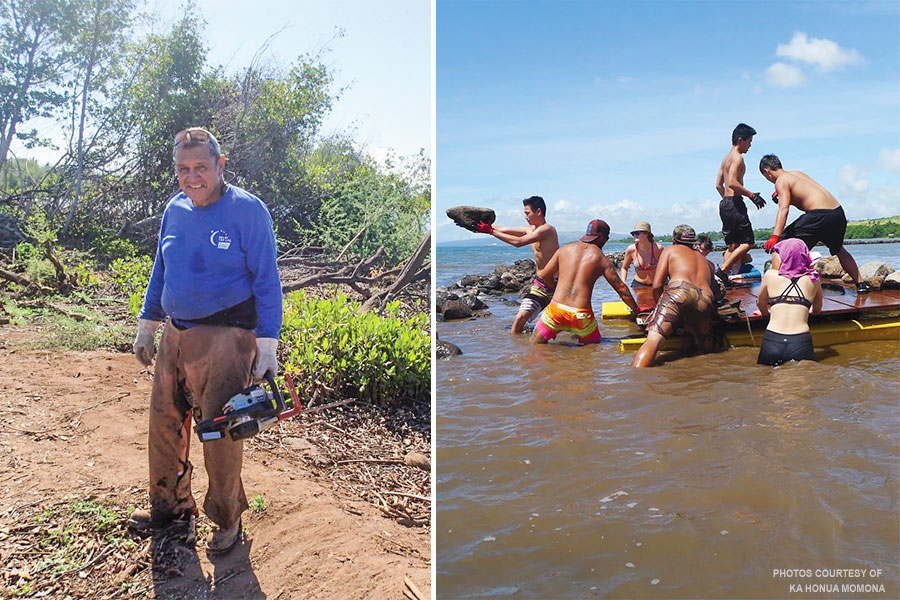
Restacking the Stones
“You know what you do with the young kids?” asks Mervin Dudoit. “You play one game of ‘Pull and Slap.’ You pull out the mangroves and slap ‘em in da bucket. It keeps the kids entertained.”
It’s one of the activities “Uncle Merv” uses with school groups and volunteers who come to restore and learn about Moloka‘i’s ancient system of fishponds. Since 2003, he and the nonprofit Ka Honua Momona (“the bountiful Earth”) have been repairing Ali‘i and Kaloko‘eli fishponds. Built by hand, the pond walls arc out from shore, punctuated by a mākāhā, or sluice gate, that allows small fish to enter and feed, but traps them inside once they grow. Whatever tempests happened at sea, fishponds provided Hawaiians with a secure and sustainable food source. It’s a process Dudoit wants the next generation to learn and work to bring back.
A lifelong ocean fisherman, Dudoit has had to learn the skills of successfully managing a pond, but if you “look and pay attention,” he says, “the Hawaiians will show you what they did.”
For example, when Hawaiians built the fishpond walls over 600 years ago, they stacked the rocks without mortar. Dry stacking leaves spaces between the rocks, allowing water to flow through to aerate the ponds, though over time some rocks have toppled from waves, currents, and tides. Dudoit has volunteers wade into the warm, waist-deep waters, and retrieve the original rocks from the bottom to dry stack the walls once again. He and his volunteers have restored over 500 feet of wall, or kuapā, at Ali‘i fishpond alone. As long as the ponds receive regular maintenance, those walls will stand.
The work is back straining, but the sense of connecting with early Hawaiians, and learning traditional methods, has sparked an interest among Moloka‘i’s youth. “When the kids come to help out,” says Dudoit, “we put ‘em in the pond and we make them work hard.” He can tell they’re interested, because “They ask a lot of questions, like ‘Why this?’ and ‘Why that?’”
One of those “whys”: Why do they walk barefoot out through the mucky pond bottom? The reason, Dudoit explains, is to dredge the pond as their ancestors did, by breaking up sediment with their feet and allowing the current and outgoing tide to carry it out to sea. Because that sediment is evidence of runoff from shore, it’s also a reminder to care for the land: What happens mauka (inland) affects the life of the ocean. “I tell ‘em do it for the kūpuna,” Dudoit adds, “because important to take care of dem.”
Those kūpuna (island elders) love receiving ‘anae (mullet), and Dudoit teaches youth when to harvest, and when to leave fish alone. The season for mullet begins April 1, but Dudoit cautions, “If you throw net and see some still have eggs, then you gotta wait little bit longer.”
In front of the office at Ali‘i fishpond, kalo and papayas grow, but it’s the ponds where Mervin has set his hopes. “We do this ‘cuz we want to see the culture come back—teach the right way fo’ do it. Most the fishponds on the island are broken. [If] you bring ‘em back you can feed Hawai‘i, pretty much guaranteed.”
Info: 808-553-8353 or KaHonuaMomona.org





